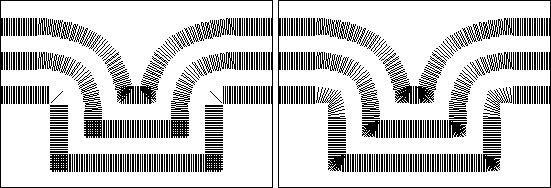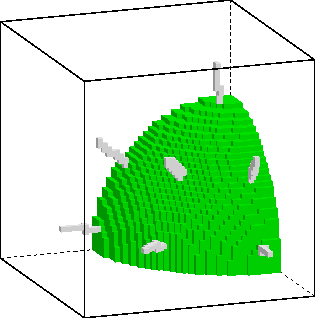[<]
[^]
[>]
[TOC] Prev: 3.1.1 Spherical Segments
Up: 3.1 Isotropic Etching/Deposition
Next: 3.1.3 Benchmark Example
3.1.2 Linear Elements
A further possibility for CPU time reduction is the restriction to exclusive
application of lines as structuring elements, similar to a ray-trace algorithm.
The length of the lines is determined by deposition rate and time. In case of
isotropic deposition the growth direction is perpendicular to the surface.
For this method it is necessary to calculate the surface orientation which is
not implicitly given in the cellular material representation. The calculation
of the surface orientation is done by averaging the cube face normals of cells
within a certain distance from the considered surface cell. By a special edge
detection algorithm it is possible to conserve sharp corners of the initial
geometry, which otherwise would be rounded by the averaging
algorithm. Fig. 5 shows surface normals calculated in this way for a
cylindrical via structure for different time steps, with and without edge
detection.
Figure 5:
Surface normals for three different time
steps of isotropic deposition into a cylindrically shaped via. The edge
detection on the left hand side conserves the vertical and horizontal surface
normals at the edges of the initial geometry. The surface normals resulting
from the averaging algorithm without edge correction is shown on the right
hand side.
 |
This method is similar to ray-trace algorithms. If the linear structuring
elements corresponding to the rays are dense enough, a smooth surface is
assured. Special care has to be taken at corners or edges where the linear
structuring element has to be applied repeatedly with directions
interpolated between the surface orientation of the adjacent cells for
assuring a smooth and continuous surface. This interpolation at edges is
different from the averaging method used for the calculation of the surface
normals (see right hand side of Fig. 5), which would not be able to
correctly reproduce the isotropically deposited layer.
In contrast to the spherical segment algorithm this algorithm performs
better for curved surfaces. Only cells very close to the surface are hit
repeatedly (see Fig. 6) and this effect is only pronounced when
interpolating at edges. Fig. 6 where the linear structuring
elements are applied at the same positions as the spherical segments
in Fig. 4 gives an idea of the further reduction of redundant
operations achievable with this algorithm.
Figure 6:
Linear structuring elements normal to
the surface introducing very low redundancy.
 |
[<]
[^]
[>]
[TOC] Prev: 3.1.1 Spherical Segments
Up: 3.1 Isotropic Etching/Deposition
Next: 3.1.3 Benchmark Example
W. Pyka, R. Martins, and S. Selberherr: Optimized Algorithms for Three-Dimensional Cellular Topography Simulation

